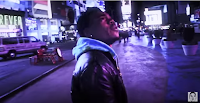"Music videos ignore common narrative as they are essentially advertisements. As consumers, we make up our own meaning of a song in our minds: a music video can anchor meaning and gives the record company/artists a method of anchoring meaning."I'm going to apply this statement to the music video for Chance The Rapper's 'Juice'.
At the very start of the video it is clear that an aspect of this music video is an advert for the song.
Right at the start there is a slide with the rappers social media and a hashtag for the song, and then again there is his name and the name of the song imposed upon the background of the video. After this there is a bit more meaning portrayed through the video.
This still shows chance looking around New York almost in confusion. Considering the song is about his rise to fame and being recognized within rap, it could suggest that he isn't prepared or doesn't understand it to some extent. The setting of New York helps to portray this as it is one of the busiest cities in the world and arguably home to capitalism, therefore perhaps a metaphor for the success he has achieved. That said, it is not abundantly clear and allows the viewer to develop their own meaning, as suggested by Goodwin.
These two screenshots help to imply the idea that Chance has made it, as the lyrics to the song say. There are adverts for his music on the billboards at Times Square, which would show he has a lot of money to be able to pay for them, and also give him great exposure. Whilst it is highly likely they have been edited in, it goes to show, again through the method of setting, that Chance is gaining a lot of fame.
This is a convention of rap videos, with the rapper addressing the camera and the audience. This use of camera work and performance helps to create the idea that the rapper is talking directly to the viewer and makes it feel like there is a bond between the two. Tied in with another convention of rap which is talking about how successful you are, this may be an attempt to make the viewer feel a part of this success.
This long shot on Chance is arguably an advertisement and cross promotion with Foot Locker. His shoes are deliberately shown as clearly as any other shot in the video and the long shot also clearly includes the Foot Locker logo. There are many other logos shown throughout the video, such as Pepsi, which are repeatedly prominent however being on Times Square its hard to know whether or not they were deliberate, but on this occasion it clearly is. The colour of his shoes helps as they are the same colour as the foot locker logo.
In summary, there is only really a vague narrative to the music video, as Chance moves through times square. As Goodwin suggests, this video seems a lot more like an advert for the song, rather than a story in itself. I also agree with Goodwin in that as a viewer of this music video, any meaning is one that you look for and not one that strikes you immediately. Seeing the rapper walk through Times Square isn't something that gives off a powerful message instantly. However, analyzing it, you see aspects such as the adverts for his song in the background and it is striking that the rapper is being shown as a big deal. This could also link to the ideas of Stuart Hall, which are that the producer wants to the audience to take a specific meaning from the video. Showing Chance as a celebrity within the music video may be an attempt at subliminal messaging to create this idea in reality. In some ways, despite the conflict in ideas from Hall and Goodwin as far as narrative, the two different theorists ideas can work together in this video; the music video is an advertisement for the rapper and the song (Goodwin) and this is depicted clearly within the video to have the effect of an advert of the audience (Hall). Overall, the fact that there is not a clear narrative is something that I think is fairly conventional for the genre of rap. A big part of the genre is talking yourself up and this is not something that usually translates to a story telling type song. However, rap is often most powerful when telling a story, as evident through Eminem's Stan and therefore it is something that is also common but not as conventional.







